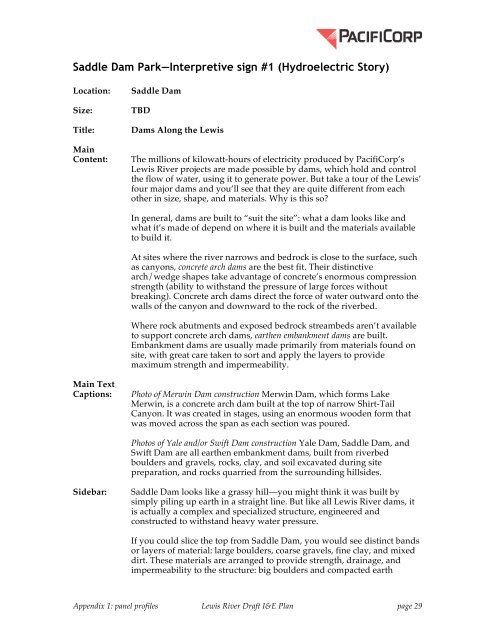The Lewis River Hydroelectric Projects - PacifiCorp
The Lewis River Hydroelectric Projects - PacifiCorp
The Lewis River Hydroelectric Projects - PacifiCorp
Create successful ePaper yourself
Turn your PDF publications into a flip-book with our unique Google optimized e-Paper software.
Saddle Dam Park—Interpretive sign #1 (<strong>Hydroelectric</strong> Story)<br />
Location:<br />
Size:<br />
Title:<br />
Main<br />
Content:<br />
Saddle Dam<br />
TBD<br />
Dams Along the <strong>Lewis</strong><br />
<strong>The</strong> millions of kilowatt-hours of electricity produced by <strong>PacifiCorp</strong>’s<br />
<strong>Lewis</strong> <strong>River</strong> projects are made possible by dams, which hold and control<br />
the flow of water, using it to generate power. But take a tour of the <strong>Lewis</strong>’<br />
four major dams and you’ll see that they are quite different from each<br />
other in size, shape, and materials. Why is this so<br />
In general, dams are built to “suit the site”: what a dam looks like and<br />
what it’s made of depend on where it is built and the materials available<br />
to build it.<br />
At sites where the river narrows and bedrock is close to the surface, such<br />
as canyons, concrete arch dams are the best fit. <strong>The</strong>ir distinctive<br />
arch/wedge shapes take advantage of concrete’s enormous compression<br />
strength (ability to withstand the pressure of large forces without<br />
breaking). Concrete arch dams direct the force of water outward onto the<br />
walls of the canyon and downward to the rock of the riverbed.<br />
Where rock abutments and exposed bedrock streambeds aren’t available<br />
to support concrete arch dams, earthen embankment dams are built.<br />
Embankment dams are usually made primarily from materials found on<br />
site, with great care taken to sort and apply the layers to provide<br />
maximum strength and impermeability.<br />
Main Text<br />
Captions:<br />
Photo of Merwin Dam construction Merwin Dam, which forms Lake<br />
Merwin, is a concrete arch dam built at the top of narrow Shirt-Tail<br />
Canyon. It was created in stages, using an enormous wooden form that<br />
was moved across the span as each section was poured.<br />
Photos of Yale and/or Swift Dam construction Yale Dam, Saddle Dam, and<br />
Swift Dam are all earthen embankment dams, built from riverbed<br />
boulders and gravels, rocks, clay, and soil excavated during site<br />
preparation, and rocks quarried from the surrounding hillsides.<br />
Sidebar:<br />
Saddle Dam looks like a grassy hill—you might think it was built by<br />
simply piling up earth in a straight line. But like all <strong>Lewis</strong> <strong>River</strong> dams, it<br />
is actually a complex and specialized structure, engineered and<br />
constructed to withstand heavy water pressure.<br />
If you could slice the top from Saddle Dam, you would see distinct bands<br />
or layers of material: large boulders, coarse gravels, fine clay, and mixed<br />
dirt. <strong>The</strong>se materials are arranged to provide strength, drainage, and<br />
impermeability to the structure: big boulders and compacted earth<br />
Appendix 1: panel profiles <strong>Lewis</strong> <strong>River</strong> Draft I&E Plan page 29
















